Cisco’s Take on Real-World 6GHz Performance
Cisco recently participated in Mobility Field Day 7, hosted by Tech Field Day. Cisco presented on several topics, including:
- RF Innovation and Access Point Hardware Update
- 6 GHz Planning and Mobility Innovations Update
- Smart Buildings with Cisco DNA Spaces
- Private 5G Integrated with Enterprise Networks
While several items Cisco presented on caught my attention, I wanted to focus on the 6GHz performance testing covered by Jim Florwick (@florwj) during the 6GHz Planning and Mobility Innovations presentation.
This specific presentation focused on 4 things:
- Wi-Fi 6E design recommendations
- AI-Enhanced RRM CiscoLive 2022
- CleanAir Pro
- Zero-Wait DFS
Out of these four topics, I wanted to drill down on Wi-Fi 6E design recommendations.
For many months, there have been many claims on best practices for 6GHz design with little practical feedback based on operational experience beyond a lab environment. There has been much comparison between the physics of 5GHz and 6GHz. Some key points of concern include the following three items.
Path Loss
While technically 5GHz and 6GHz signals travel just as far, the reality is that antenna sizes are not the same and therefore different amounts of energy are collected on each band, giving the illusion 5GHz signals travel further than 6GHz.
The effect of different sized antennas is emphasized when comparing 2.4GHz against 5GHz. In practice, 2.4GHz antennas are often twice the length of their 5GHz counter parts. Imagine two sailing boats, with one boat having a sail twice as large as the other boat. Which sail would collect more energy [wind] and which one would go faster?
As 5GHz and 6GHz are much closer in the spectrum band, the delta between antenna sizes is not as pronounced and the effect is not as significant even though a 6GHz antenna needs to be tuned to cover a range of 1200MHz.
Cell Size
Two equations relate to the signal strength measured at specific frequencies based on a given distance travelled from the radiator/transmitter. These two equations are the FSPL and the inverse square law.
Briefly, the Free Space Path Loss (FSPL) equation describes the attenuation of a signal between a transmitter and receiver across free space with open and unobstructed line of sight (LoS). It is important to appreciate that FSPL is based on two variables – frequency and distance and has nothing to do with the type or model of antenna.
Where:
d is distance in meters (m)
f is frequency in hertz (Hz)
The inverse square law states that the quantity of energy is inversely proportional to the square of the distance from the source of that energy.
Looking back at legacy bands (2.4 & 5GHz), if identical transmit power was used (i.e. 100mW/20dBm) on both the 2.4 and 5GHz radios, the RSSI measured at a given location on the floor (e.g. 6m away from the AP) would show the 2.4GHz signal as approximately 6dB greater than that of the 5GHz. Legacy client drivers were often programmed to prefer connecting to the loudest radio, regardless of the band. As a result, those legacy WLAN NICs preferred to connect to the 2.4GHz radio as it appeared roughly 6dB louder at any given distance from the AP. This effect is shown in the image below:
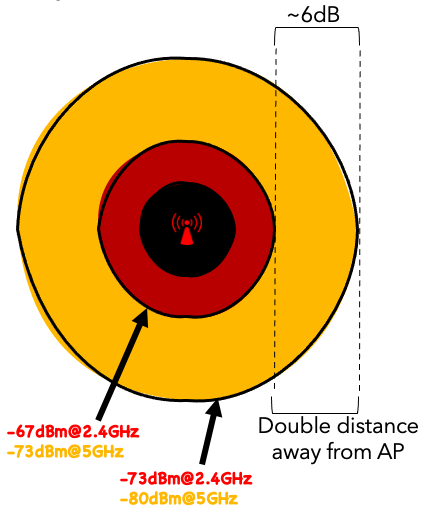
To compensate for this effect, designers often reduce the transmit power of the 2.4GHz radio by ~6dB to create similar sized cells. For example, the 5GHz radio could be configured as 14dBm/25mW and the 2.4GHz radio as 8dBm/6.25mW. With this configuration, RSSI values would appear almost identical between both radios for client devices, allowing WLAN NICs to make better choices regarding which band to associate. The image below shows the results of this configuration change resulting in near identical RSSI values between both 2.4 and 5GHz at the same distance away from the AP:

From the FSPL equation, we know that higher frequencies experience rates of loss and therefore it should be no surprise that 6GHz path loss is greater than 5 and 2.4GHz (6GHz > 5GHz > 2.4GHz loss). It’s worth noting here that 5GHz is roughly double the frequency of 2.4, hence the 6dB delta is negated with equal transmit power. 6GHz is certainly a higher frequency than 5GHz but it is only 20% greater, not 200%. As a result, the difference in cell size between 5GHz and 6GHz is not as significant compared to the difference found between 2.4 and 5GHz.
Comparing RSSI values of signals on channel 100 (5.5GHz) vs channel 117 (6.535GHz) at a distance of 6m from the AP results in a delta of roughly 1.5dB. At this distance, and assuming equal transmit power, 1.5dB translates to a cell size difference of roughly 1m. The difference in RSSI values can easily be matched by reducing the transmit power of the 5GHz radio by 1-3dB. The image below shows a visual comparison between the 5GHz and 6GHz bands using the values listed above:
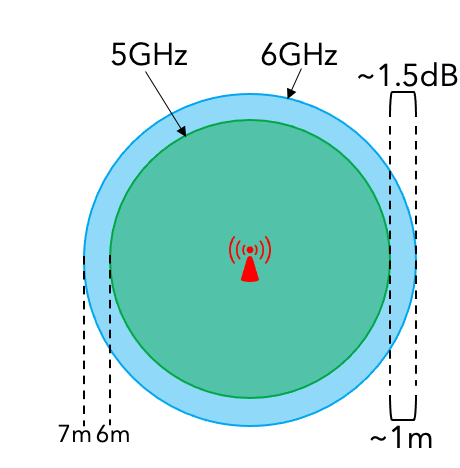
As a result, there is negligible difference in cell sizes between the 5GHz and 6GHz bands using equal transmit power. It’s worth noting that comparison between channels in the extreme case of opposite ends of the spectrum – channel 36 (5GHz) vs channel 233 (6GHz) – results in a RSSI delta of only 3dB.
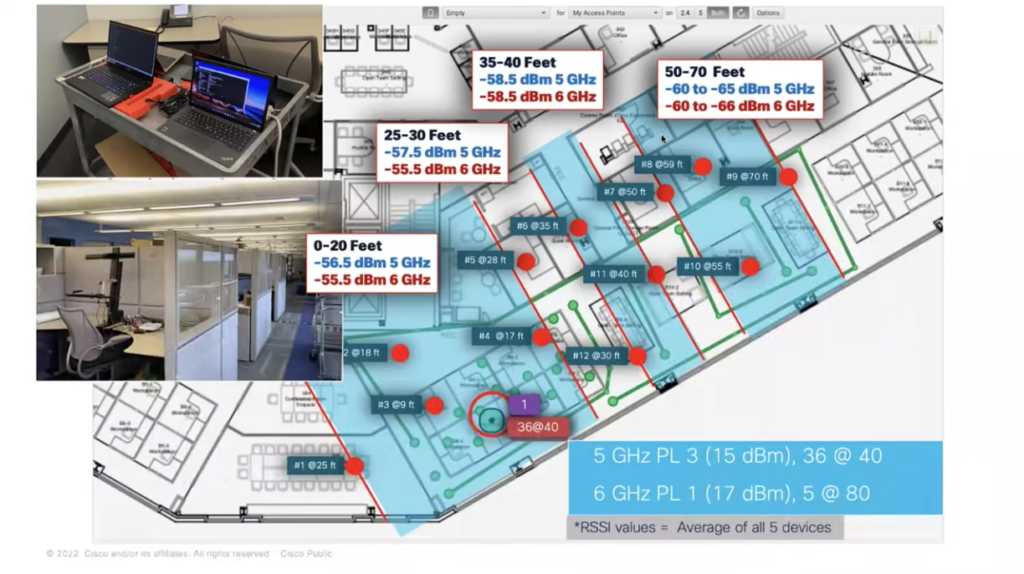
Lastly, there is a difference between the cell size of the AP versus that of the client. With 6GHz, maximum PSD EIRP values in the FCC domain are 5dBm for APs vs -1dBm for clients, as shown in the image below:

Absorption / Reflectance
Different objects and materials have various impacts on the interaction with waves of different frequency. Generally speaking, signals with higher frequencies experience greater absorption when passing through walls and other objects, but there are some exceptions. Additionally, higher frequencies tend to have higher reflection co-efficient resulting in more energy reflected back from walls or objects. The net effect being less energy makes its way to the other side of the object.
For this reason, there is value in being able to define different attenuation values for each band. Here again, the effect of absorption and reflectance through different materials is much more significant when comparing 2.4GHz vs 5GHz as the frequency has doubled. The relative difference between 5GHz and 6GHz is small in comparison.
There is an excellent white paper detailing the measured impacts of various materials across different frequencies which can be found listed in a previous post I wrote.
Back to Cisco’s Data
All of these concepts seem to align with the data presented by Cisco showing minor RSSI coverage differences between 5GHz and 6GHz. What was significant was the throughput results between the two bands. Now keep in mind that it is a little unfair comparing a 20MHz wide channel on 5GHz against an 80MHz wide channel on 6GHz, but with the dynamic PSD (power spectral density) and the massive amount of spectrum available on 6GHz (1200MHz), it is a valid comparison between two real-world deployment configurations on the two bands.
At the end of the day, Cisco is concluding minor differences in the RSSI coverage between 5GHz and 6GHz for real world deployments in high density environments. In fact, Cisco goes as far as to suggest one-to-one replacements of Wi-Fi 5/6 APs with Wi-Fi 6E APs can be achieved. (Caveat: This recommendation assumes 1,200-2,000 sqft (111-186 sqm) with average AP density in a carpeted office with normal ceiling height (3m/10ft)). All of this comes with the added bonus of a massive increase in throughput performance on the 6GHz band.
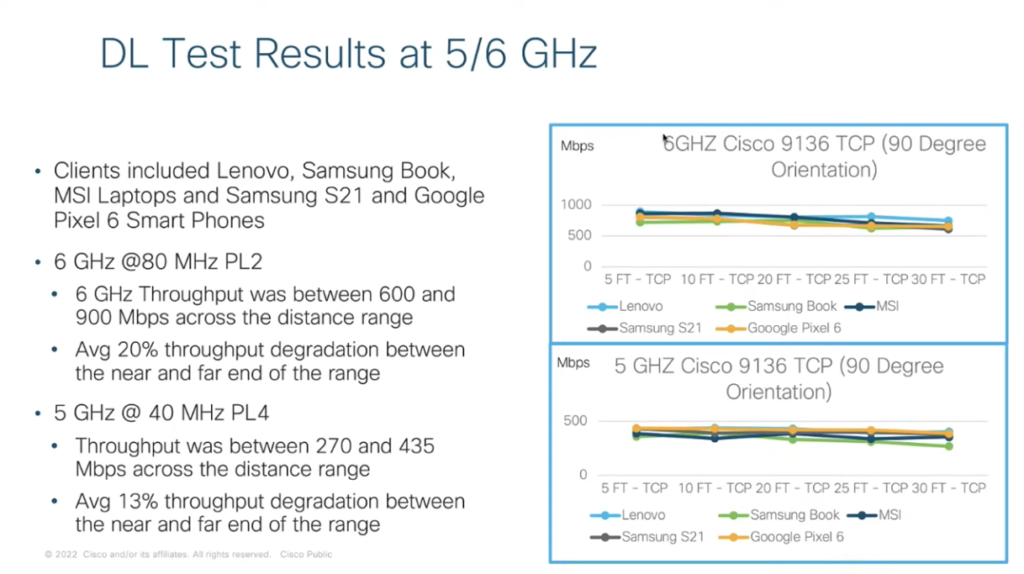
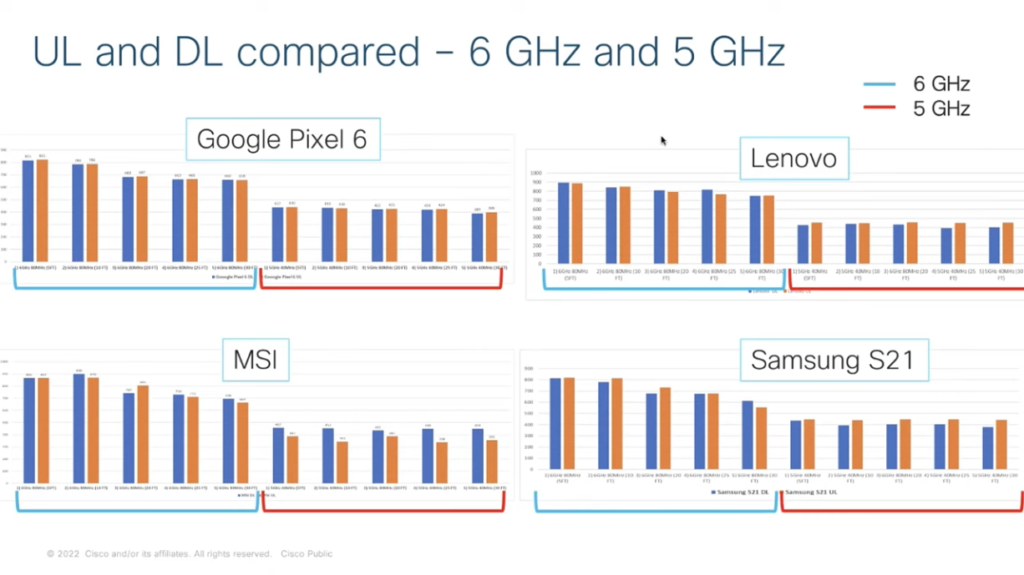
This sounds like another significant win for Wi-Fi 6E and the sooner the industry can migrate to this band the better.
While Intel has identified 792 commercially launched Wi-Fi 6E devices in 2Q22, the industry is still months, if not years, away from reaching critical mass of 6GHz capable devices deployed in most WLAN environments.
Finally, it was interesting to note that CiscoLive 2022 in Las Vegas was operated on 5GHz using mostly 11ac radios. The existing conference centre APs were used, which did not support 11ax and there were very small pockets of Wi-Fi 6E deployed – it was certainly not pervasively deployed across CiscoLive.
A conference full of networking geeks was successfully run on a 5GHz WLAN. This speaks volumes to the impact of proper design in WLAN deployments!
Slàinte!
Resources:
All MFD7 presentations are available on the MFD7 YouTube channel here.
Cisco High Density AP/Deployment Guide